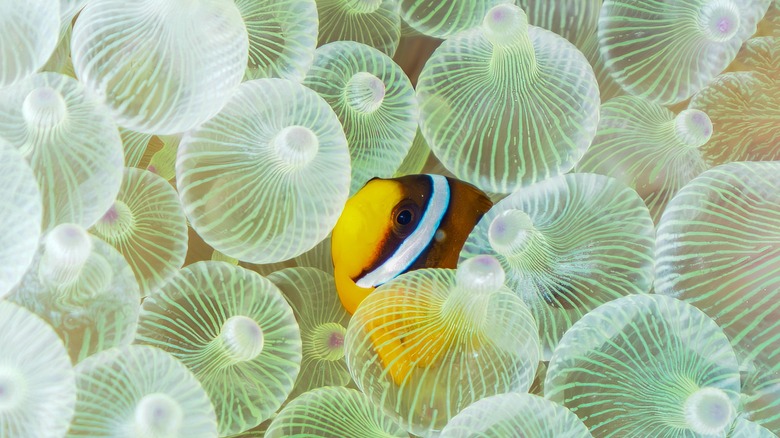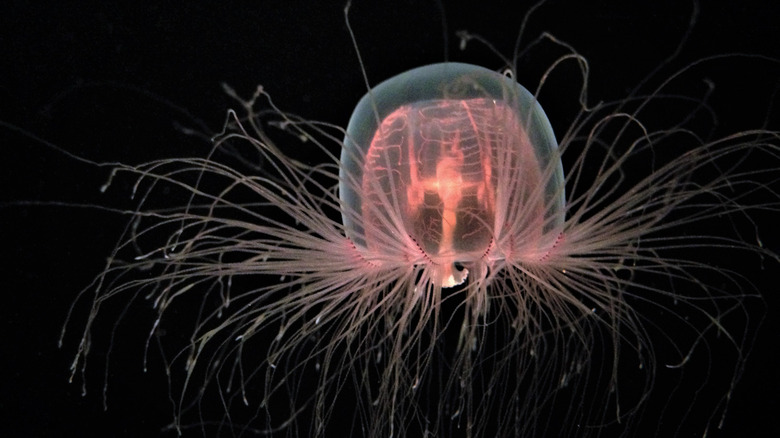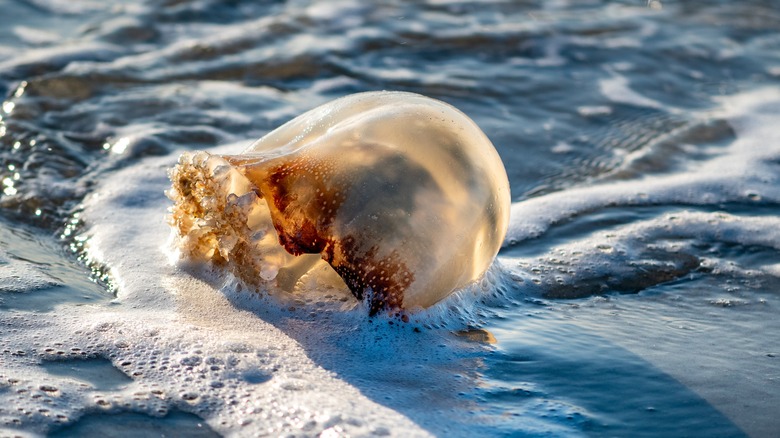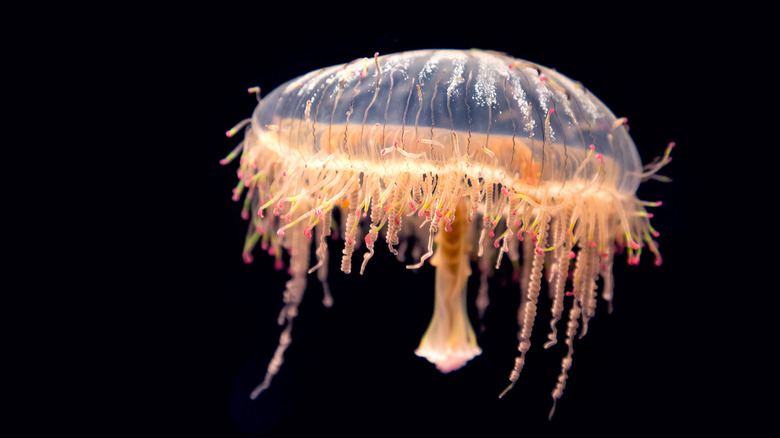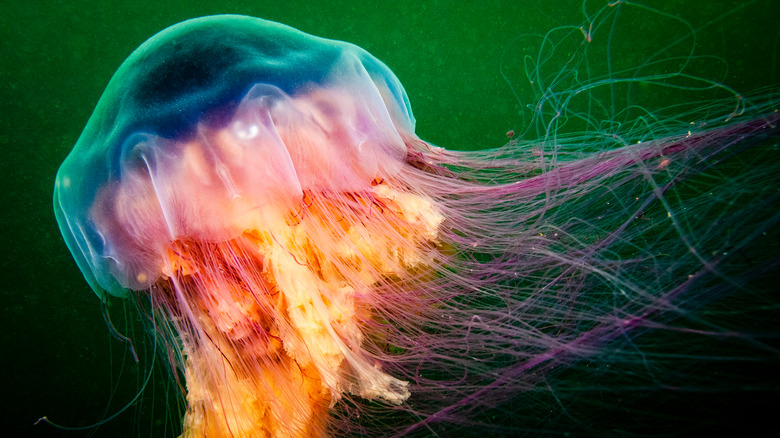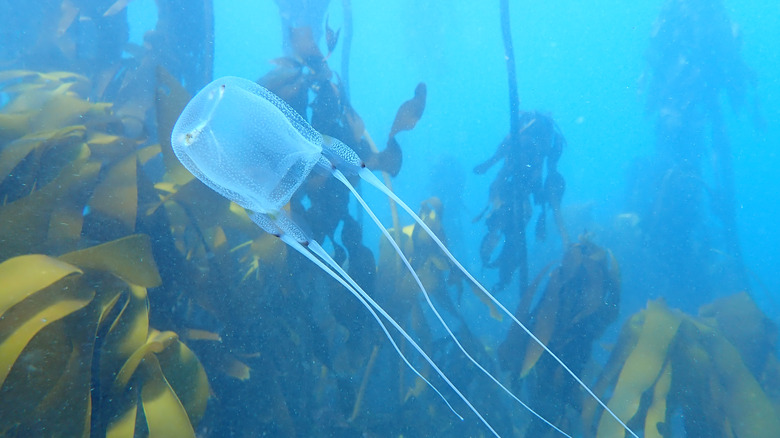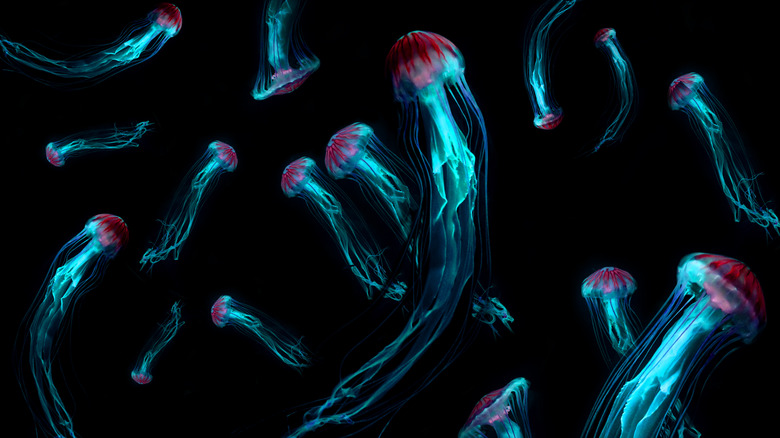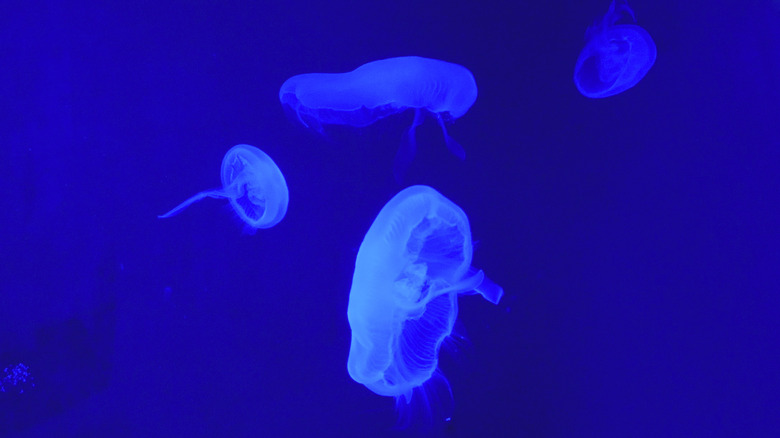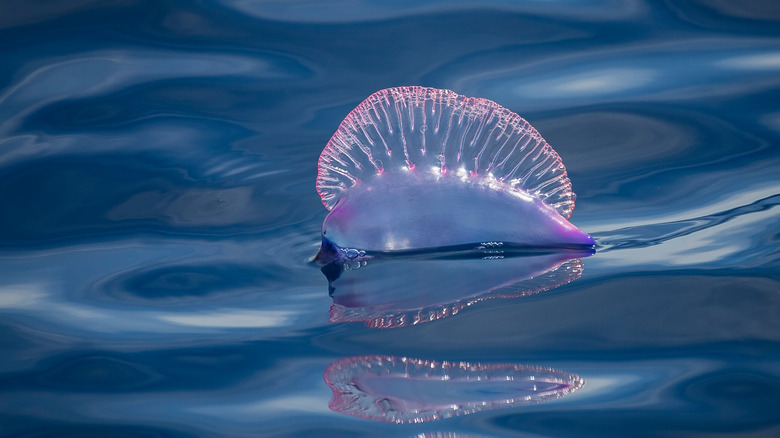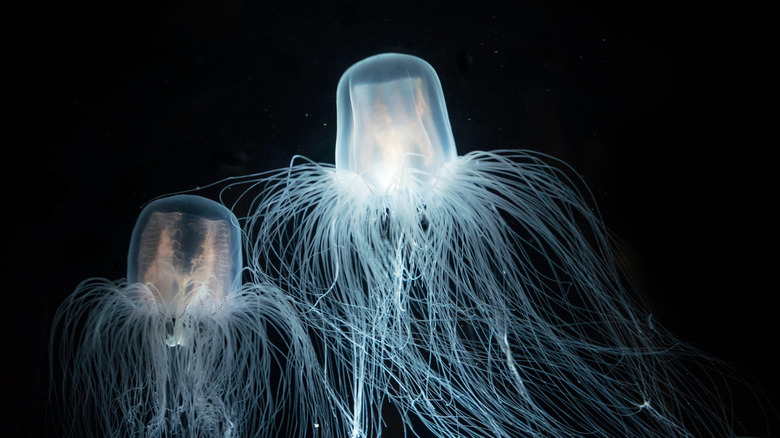11 Types Of Jellyfish, Ranked By Danger Level
Jellyfish are among the most fascinating creatures in the world. Without brains, hearts, eyes, or bones, they somehow manage to survive and thrive in the ocean, arguably the harshest environment on the planet. Despite not having the organs we commonly associate with intelligent life, jellyfish have to be smart and tough. Otherwise, they won't make it very far. Here's the thing, though. Fascinating though they may be, nearly all jellyfish have the capacity to harm humans and other creatures.
This is because jellyfish are equipped with stinging tentacles. These dangle below their body like electrically charged wind chimes. They will eat shrimp, fish, crabs, and a host of other creatures. It's these very tentacles that people need to be wary of.
Though it can be difficult to identify one if you're not under the water, it is best to know the jellyfish are going to cause the least or most amount of damage to you. While most jellyfish have the ability to sting, not all stings are going to cause life-threatening injuries. The ranking of these 11 jellyfish takes into account their venom and sting strength, as well as the amount of damage they can cause to a human body. The ranking goes from least to most dangerous jellyfish.
11. Immortal jellyfish
As its name suggests, the immortal jellyfish is, well, practically immortal. Unless something comes along and eats it, the immortal jellyfish will continue to reset its lifecycle indefinitely. This miraculous feat only occurs when the jellyfish has been harmed or is on the brink of starvation. In response, it winds back its biological clock to the time when it was a small larva. This does put the jellyfish at risk of being eaten by other sea creatures, but if it escapes this fate, the immortal jelly can go on living, theoretically, forever.
The immortal jelly is ranked dead last because scientists are using its regenerative properties to see whether or not the jellies contain properties that could extend human life. As the Immortal jellyfish is able to regenerate its cells, scientists are attempting to determine exactly how this cell and tissue regeneration works so that they can apply it to human medical situations.
This is hardly the only reason why the immortal jellyfish is the most harmless of all jellyfish. It also happens to be a non-venomous jellyfish with no stinging cells on its tentacles. This means that if you brush one while you're snorkeling, scuba diving, or swimming, no harm will come to you. Though, there's a chance you might startle it enough to watch it turn itself back into a larva.
10. Cannonball jellyfish
Known for their spherical shape and lack of long, trailing tentacles, cannonball jellyfish are considered one of the most important jellyfish species. Producing in abundance in the waters of the Pacific and western Atlantic oceans, cannonball jellies feed on zooplankton, which is typically how they end up so close to shore. Beachcombers often see several of these jellyfish washed up on the shore after a good surf.
Though they do not have the long, dangerous tentacles of other jellyfish on this list, the cannonball can nevertheless produce a low-pressure sting if it wants to. This sting is a defense mechanism only, as the cannonball relies on its sticky mucus membrane to catch its prey. The impact of a sting on a person is incredibly low and results in no lasting damage.
The cannonball jellyfish is also beneficial as a food source. Popular eating in many Asian countries, there is a thriving cannonball fishing industry in the United States that catches the jellies and ships them overseas. Cannonball jellyfish can be cut into strips and served in salads, sushi, stir fry, and egg rolls. They're a fantastic source of collagen proteins, so it might be worthwhile to test one out if it appears on a menu.
9. Moon jellyfish
If you're kayaking or snorkeling in the evening in the warm waters of the Pacific, you might see what appear to be little moons glowing and floating just below the surface. What you're witnessing is bioluminescence, a key feature of some species of the ethereally quirky moon jellyfish. Its translucent, glowing white-sliver skin is what gives it such an otherworldly appearance. Within the translucent bell, you can see the major organs of the jellyfish, as well as their flipper-like stingers extending below.
Though they are among the coolest looking of all jellyfish, do not be fooled by this appearance. The moon jellyfish comes equipped with a good sting that will make you think twice about reaching out to touch one. It's hardly more than a jolt, but it's enough to make you recoil. Stinging is not, however, the area where the moon jellyfish causes the most harm.
The moon jellyfish has a tendency to overpopulate areas it finds to be particularly plentiful in terms of food and water temperature. Their overbearing presence can cause issues among the other wildlife in the area. So, while it's relatively harmless to people, for other ocean dwellers its presence can be rather unwelcome.
8. Flower hat jellyfish
In outward appearance, the flower hat jellyfish looks like the type of hat the late Queen Elizabeth II would wear to a horse race. Caked in fluorescent colors, pinstripes, and frills along its translucent bell, the Flower Hat jelly has to be the most unique-looking jellyfish in the entire ocean. Found off the coasts of southern Japan, Argentina, and Brazil this jelly feeds on small fish that it lures in with its colors and then paralyzes with its stinging tentacles.
It's these very stingers that can cause harm to humans. There is an old rule in the study of animal science that states if the creature is boldly colored enough not to require camouflage, stay away from it. Much is the case with the flower hat jelly. Fortunately, unlike poison dart frogs, flower hats pass along a venom that is only mild to humans. At most, someone who is stung will get a skin irritation.
As a nocturnal hunter, the chances of actually running into the flower hat jellyfish are slim. It tends to spend the daytime resting on the seafloor and is not altogether sociable.
7. Lion's mane jellyfish
By far the largest jellyfish in existence, the lion's mane jelly can measure as long as 120 feet. It is a fearsome, fascinating creature. Something of a gentle giant, lion's mane jellies will actually protect some schools of fish from other prey. These fish species are immune to the lion's mane venom and are perfectly at home hiding among its long web of stinging tentacles. It is other creatures, especially people, who need to watch out for these stingers.
The long tentacles of a lion's mane jellyfish are lined with stinging cells that, when in use, will paralyze prey. The prey then gets scooped up and consumed by the jellyfish. When in contact with a person, the tentacles can leave behind a powerful sting and a nasty welt on the skin. The venom isn't potent enough to cause any real damage to a person unless they get caught up in the mane while underwater. Much like the venom of a stingray, the lion's mane venom can be drawn out with hot water.
Lion's mane tentacles are even more dangerous if they've fallen off of the jellyfish. Any tentacles that get removed from the jelly maintain their sting for several days, so if a beachcomber happens across one unknowingly, they will be in for quite a shock.
6. Box-within-a-box jellyfish
The box-within-a-box (BWB) jellyfish is an enigmatic creature that often gets lumped into the same pool as its harmful cousin, the box jellyfish. The BWB is distinguished by its shape, which is unique among jellyfish. It's almost square and has multiple layers, which make it look as though it is constructed out of boxes stacked on top of one another. As a member of the box jellyfish family, the damage one of these creatures can do is pretty significant.
While its venomous sting is considered moderate on the jellyfish pain scale, one should nevertheless be extremely cautious around a BWB. It is not an overly large jellyfish, but it still presents a threat due to its longer tentacles and propensity to swim in shallow waters during the day.
This behavior means that swimmers are more likely to come into contact with these jellyfish than they are with many others. The BWB jelly is a native of the Pacific Ocean and is found off the shores of many Asian countries.
5. Sea nettle
Moving into the more severe stings category, we have the sea nettle jellyfish. A rather beautiful-looking jellyfish with an orange hue, long tentacles, and a sun pattern etched into its bell, the sea nettle is another jellyfish that prefers to inhabit the coastal waters of nations in the Pacific, though it has been spotted off the coast of Florida in the United States.
Because of their tendency to bloom in areas that they like, sea nettles can show up in their thousands. Beachgoers will be able to know whether or not the water is safe to swim in by the type of beach warning flag that is flying on the day. Solid purple means that there is an abundance of dangerous marine life, like sharks or sea nettles, and that swimming is ill-advised.
While the sea nettle's sting is mild, its blooming habit can cause a lot of problems both for swimmers and fellow marine life. For swimmers, being stung by multiple sea nettles is going to cause a fair amount of damage to the skin. The reactions to the sea nettle sting are very painful, and if they are coming at you in numbers, you won't be going away unscathed.
4. Irukandji jellyfish
An incredibly small jellyfish, you wouldn't peg the Irukandji as being anything other than an adorable little ball that floats around in shallow water. You would, however, be quite mistaken. Despite its stature, the Irukandji jelly packs quite a punch. It should come as a surprise to no one that this dangerous jellyfish is native to the waters of Australia. Whether it's snakes or spiders, Australia is a known home to some of the most dangerous creatures in the world. Jellyfish are no exception.
There is an element of trickery at play with the Irukandji jellyfish. Though it has one of the more potent stings, the effects of said sting might not show up for nearly an hour after being stung. A person will certainly know that they've been stung, with the powerful shock emanating through their body, but the severity of the sting could be delayed.
The sting of an Irukandji is known to cause backache, headache, shooting pains in the abdomen, nausea, restlessness, anxiety, and loss of breath. These jellies may be small, but they are also potentially lethal.
3. Portuguese man 'o war
No list of dangerous jellies would be complete without the Portuguese Man O' War. Though technically a siphonophore and not a jellyfish, the Man O' War is so closely related that people lump them into the same category. A native of the Atlantic Ocean, anywhere from the coast of Portugal to Florida, this creature's tentacles can extend 30 meters down into the water.
As it travels by floating atop the water, it can be difficult to gauge the size of the Man O' War from a distance. This is a clever tactic on its part because it uses its long tentacles as veritable fishing lines, extending them down deeper into the water while making itself appear to be harmlessly floating along. Passing fish will get caught in the stingers, be paralyzed immediately, and then get reeled in to be consumed.
The stinging cells that line the tentacles of the Man O' War are powerful enough, in rare cases, to kill a human being. More likely, whoever touches a Man O' War will be subject to an excruciatingly painful sting that will last upwards of 20 minutes. Vinegar can be used to neutralize the sting, but it's best to avoid these creatures altogether, even if they are washed up on the beach. Like the Lion's Mane, the Portuguese Man O' War is capable of stinging for several days after its death.
2. Sea wasp
One look at a sea wasp will tell you that it is bad news. Though jellyfish are not rigid or sharp by any stretch of the imagination, the sea wasp looks as though it could cut through you like a hot knife through butter. It's a fearsome jelly with long, bent tentacles and a translucent bell that somehow manages to look menacing. These looks are backed up by one of the most painful and venomous stings in the world.
A native of the Pacific Ocean and another lover of shallow water, sea wasps can be an absolute nightmare for swimmers. Passing by one will yield lasting pain and several skin welts where the tentacle came into contact with the skin. However, there are worse side effects to be had.
Like the Irukandji, the venom from the sea wasp can cause several side effects, including severe muscle cramping, delirium, and difficulty breathing. This last one is particularly scary, as the sting from a sea wasp is powerful enough to cause cardiac arrest, even in seemingly healthy victims. These are not jellyfish you want to cross.
1. Box jellyfish
By far the most venomous animal in the world, a single encounter with a box jellyfish can leave a person with severe tissue damage. There have been reports of people being stung by these jellyfish, which wrap their tentacles around their prey and leave permanent scarring on the skin. The pain from these stings can last not for several minutes but for several days if you're lucky enough to escape with your life.
Box jellyfish do not have a moral compass, so they do not care what they are attacking. As such, their human mortality rate is unfortunately common. In the Philippines alone, box jellies kill upwards of 40 people a year, according to LiveScience. The sting is potent enough to cause fatality within four minutes of being stung. Do not mess with these jellyfish.
Though swimming in the ocean is a popular pastime for many people, it does come with its share of risks. Wildlife is one of them, and jellyfish are among the most common forms. Found all over the world, it is imperative that swimmers understand the effects of getting too friendly with a jellyfish.
